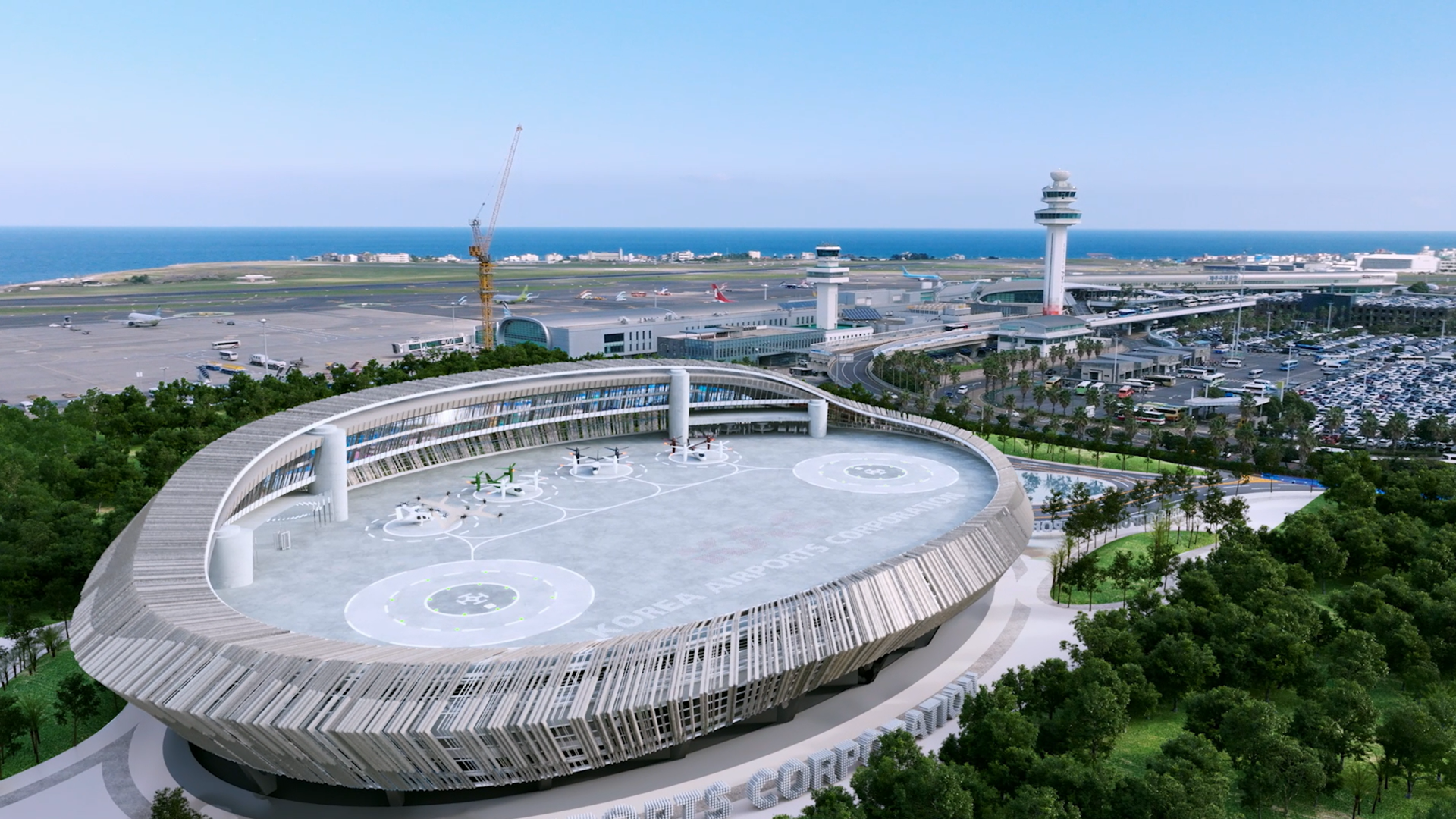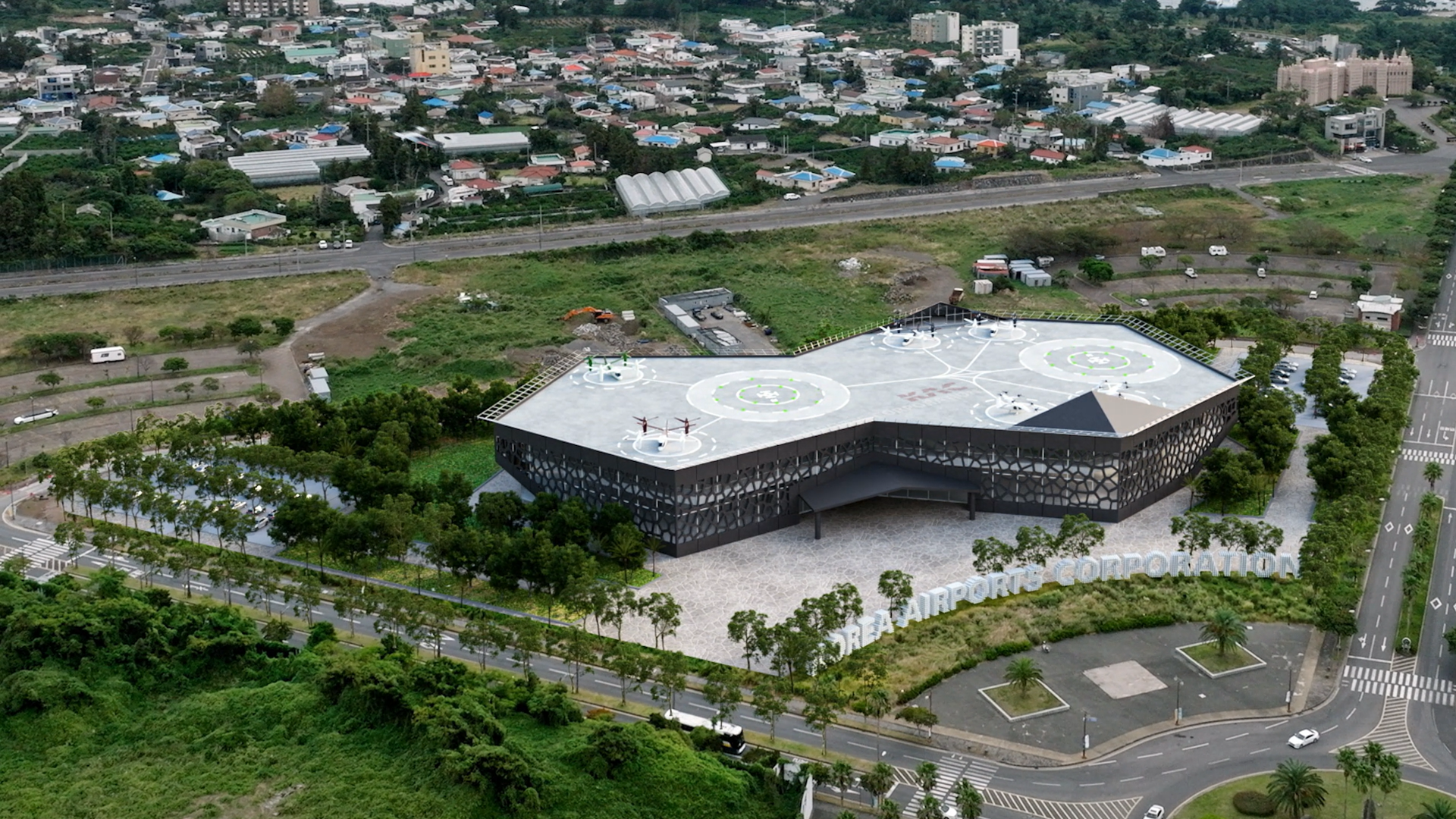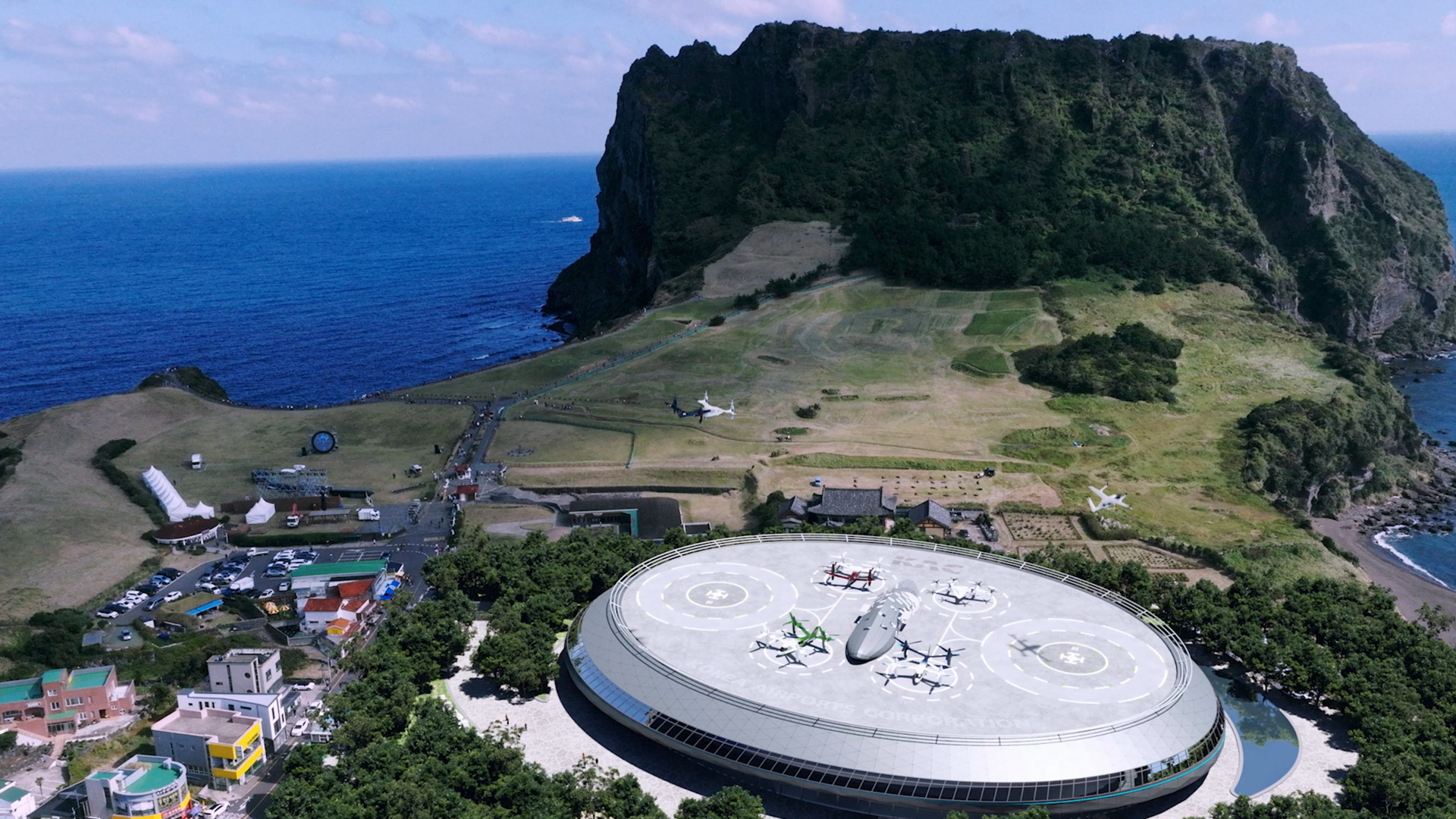Industry Trends
- Home
- Jeju Life
- Industry Trends

“UAM is not simply the advent of a new means of transportation but a big wave that will change our future completely. UAM runs on electricity and thus is an eco-friendly means of transportation. In particular, UAM could expand the tourist industry and improve convenience in everyday lives in JEJU, which has a wonderful natural environment.”
Yoon Gi-dong, a deputy department head at KAC
|
An air route that we know best |

Korea Airports Corporation (KAC) is a public enterprise that manages a total of 14 local airports in not only JEJU but also Gimpo, Gimhae, Daegu, Gwangju, Cheongju, Yangyang, Muan, Ulsan, Yeosu, Sacheon, Pohang, Gyeongju, Gunsan and Wonju. The KAC knows better than anyone else that air routes in Korea will lead the Urban Air Mobility (UAM) industry which is one of the keywords in the aviation industry. The following is the story of UAM, a new means of air transportation discussed with Yoon Gi-dong, a deputy head of the Innovative Air Mobility (IAM) project group in KAC.
Q It was told that the K-UAM Dream Team Consortium would promote the commercialization of Urban Aviation Mobility (UAM).
KAC intends to realize UAM, an eco-friendly 3D means of transportation, in collaboration with SK Telecom and Hanhwa Systems. The KAC, which knows much about air routes, airport management, and administration, will operate Vertiport, an area for vertical takeoff and landing of UAM only. SKT and Hanhwa Systems will lead the introduction and operation of UAM and the UAM traffic control, respectively. The target is to commercialize UAM by 2025, as UAM is regarded as a key industry not only in Korea but also globally.

Q For what do we need UAM?
UAM is not a means of transportation which simply uses an air route. The existing aviation industry requires resources and time of astronomical proportions for enormous airports, expensive airplanes, etc. On the other hand, UAM is a new means of transportation that could enhance the freedom of movement and destroy the boundaries of regions with relatively small amounts of resources and time. As new and innovative means of transportation, such as carriages, trains, airplanes, etc., have continued to appear, UAM would enrich our everyday lives even more. UAM that flies on electricity would become an alternative to road congestion. In the near future, people will be able to use UAM in their living radius without going to airports on the city’s outskirts, as they use buses or taxis. Also, UAM would be used in the emergency medical service or local tourist industry.
Q Why did KAC enter the UAM industry?
After all, UAM is an industry that utilizes an air route. As the roads and railroads have their own rules, an air route also has a very complicated system invisible to our eyes. Since the Wright Brothers succeeded in the first flight in 1903, the aviation industry has been developed by adopting various systems for safety. However, no matter how good the means of transportation are, they cannot be launched without social acceptability. This is why many developed countries that intend to commercialize UAM by 2025 try to commercialize UAM in its early stage based on the existing safe aviation system.
KAC determined that it is the role of public enterprise to enable the UAM industry to grow based on its know-how in airport operation and its knowledge of navigation safety accumulated for 43 years and that it is an opportunity to contribute to Korea’s industry. Thus, KAC is promoting the UAM industry.
|
In JEJU, we saw the future |

Q Please introduce the agreement for promoting the “JEJU UAM pilot project.”
In September 2022, a business agreement was entered into with JEJU Special Self-Governing Province. JEJU decided to set the first successful case of commercial UAM service in Korea by concentrating on the strength of private enterprises, public enterprises, and local governments. JEJU Province, as a representative tourist attraction of Korea, is in great demand for UAM commercialization and is able to utilize as much as possible the navigation facilities that KAC operates. JEJU also provides a lot of resources. JEJU is helping this project accelerate by providing a policy environment for promoting this project as follows: providing infrastructure and land for operating UAM; providing administrative supports and licensing necessary to construct the Vertiport; and improving the social acceptability by holding the briefing session for residents, etc.
Q Why was JEJU selected as a starting point for UAM, a new future business?
Many regions where KAC operates airports wanted to become a starting point for UAM. This is because many global consulting firms anticipate that the UAM industry will become larger than the existing aviation industry, and many large companies in Korea will enter the UAM industry.
In terms of the UAM industry in its early stage, securing social acceptability, and so-called safety is very important. Thus, KAC determines that it would be appropriate to commercialize UAM in its early stage for tourism or public use rather than as a means of transportation, such as buses, taxis, etc. which are frequently operated with a focus on punctuality. Every year, around 15 million tourists visit JEJU Province, which has a wonderful natural environment. Thus, it is deemed that demand for helicopter tourism would be substantial in JEJU as in Hawaii, Grand Canyon, etc. JEJU promotes UAM so that tourists would be able to enjoy its wonderful natural environment not only on the ground but also from the sky and move fast to a desired area.
Q I want to know a blueprint for the UAM industry that begins in JEJU.
In an early UAM industry, it is required to acknowledge that it would be very difficult to manufacture a UAM air-frame in Korea and instead revitalize a transport service industry related to it. Once the transport service industry is revitalized, the following industries would advance together: an industry that manufactures parts and components; an industry that repairs UAM and its parts and components; and an industry that educates and trains crew, operating personnel, etc. After all, the front and back industries as well as the other relevant industries, would be able to advance in JEJU only after an operation service model is completed quickly and successfully.
|
JEJU tourism restated through UAM |
Q It seems that UAM in JEJU will be viewed differently.
As to the UAM in its early stage of industry, a focus is placed on the “new means of aviation transportation” rather than the “downtown area.” This is because a starting point of UAM shall be its contact with the existing means of transportation. Most tourists to JEJU move to their accommodations or tourist attractions with public transportation or rented vehicles, after arriving at the JEJU airport by airplanes or ships from all over the country. It takes about 3 hours on average to arrive at JEJU and 1 hour or more to move within JEJU, including not only flight time but also the hours departing from home. How about within JEJU? It takes more time to move within JEJU because Hallasan Mountain is located at the center of JEJU. Thus, it is not easy to arrange travel across JEJU. However, UAM would be a solution that directly resolves this problem. UAM would maximize the charm of JEJU as a tourist attraction and take a leading role in a new type of tourist industry in light of the following characteristics of JEJU: the relatively small number of tall buildings; and the small number of restrictions on the operation of air routes, etc. Tourists could do the following with UAM: arrive at Seongsan Ilchulbong or Jungmun Tourist Complex from JEJU Airport in 15 minutes; move from accommodation by sharing cars, such as rental car, etc.; and look around Baengnokdam Crater Lake with UAM. UAM will be a new axis in JEJU tourism and revitalize the existing tourist industry.
Q “Eco-friendliness” has become a prerequisite for tourism. JEJU also claims to increase electric vehicles and become eco-friendly and resource-recirculating.
This is why UAM, which runs not on fossil fuel but instead runs on electricity, is the future means of transportation. UAM has the following characteristics: to be free from environmental pollution, such as global warming caused by smoke gas, etc.; and has little effect on the surrounding environment in terms of operation. Therefore, UAM will become a representative of eco-friendly tourism and the means of transportation representing not only the everyday lives of JEJU residents but also eco-friendly tourism. Since UAM would not replace but coexist with the existing industry, it is expected more as a new field.
Q We become more curious about how UAM will change our future.
More and more people live in the city due to its living infrastructure. On the other hand, they long for a life in nature. UAM will change our lives for sure. UAM will not only resolve the traffic congestion in the city but also enable us to move quickly, even in quiet rural lives. Also, UAM will be used even in emergencies and make tourism far more diversified and easier. In the near future, UAM will advance further in combination with future technologies, such as 6G, AI, autonomous driving, etc. The early UAM commercialization in JEJU would make JEJU a far more charming attraction in combination with JEJU’s wonderful natural environment. If JEJU becomes a center of future eco-friendly mobility with UAM, many foreign enterprises and local governments would come to JEJU to benchmark and cooperate with JEJU.
Blueprint of Vertiport to be installed in JEJU
 |
Large scale infrastructure (Vertihub) _ JEJU Airport - To accommodate 30-50 UAMs (eVTOL) - Multi-model that combines various means of transportation - Buildings that combine commercial facilities, convention facilities, etc. - Exclusive and demand responsive parking ramp where UAM is recharged |
|
Medium scale infrastructure (Vertiport) _ Jungmun Tourist Complex - To accommodate around 4-7 UAMs (eVTOL) - To expand infrastructure module - To simplify infrastructure with unused land, building rooftops, etc. - 1-2 recharging facilities, small-scale repair facilities |
|
|
|
Small scale infrastructure (Vertistop) _ Seongsan Ilchulbong - To accommodate 1 UAM (eVTOL) - To simplify infrastructure with unused land, building rooftops, etc. - To be able to be relocated, when its demand is not met - To minimize facilities for remote control, take-off and landing |

